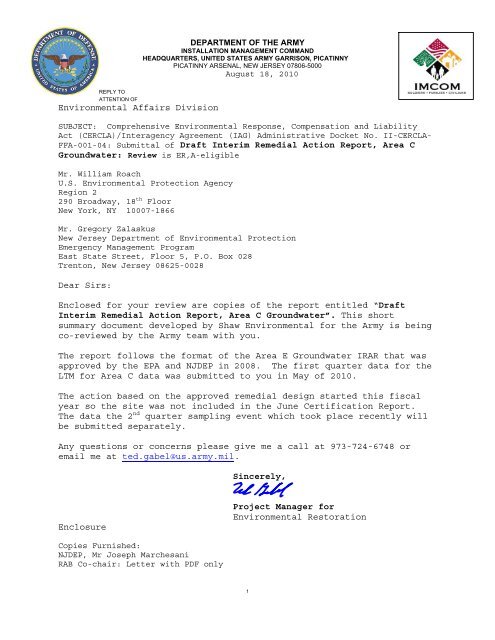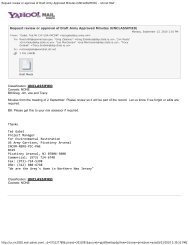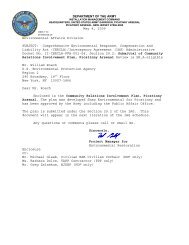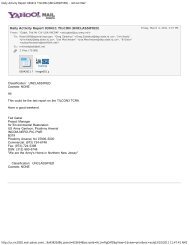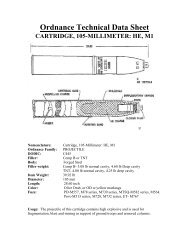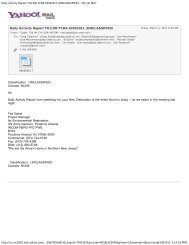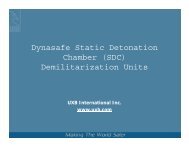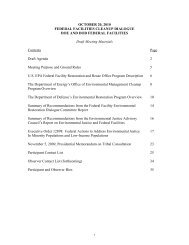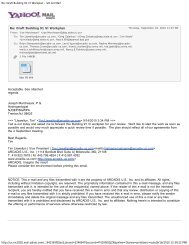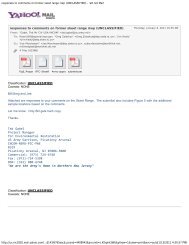submit Draft Interim Remedial Action Report for Area C Groundwater
submit Draft Interim Remedial Action Report for Area C Groundwater
submit Draft Interim Remedial Action Report for Area C Groundwater
Create successful ePaper yourself
Turn your PDF publications into a flip-book with our unique Google optimized e-Paper software.
t<br />
REPLY TO<br />
ATTENTION OF<br />
Environmental Affairs Division<br />
DEPARTMENT OF THE ARMY<br />
INSTALLATION MANAGEMENT COMMAND<br />
HEADQUARTERS, UNITED STATES ARMY GARRISON, PICATINNY<br />
PICATINNY ARSENAL, NEW JERSEY 07806-5000<br />
August 18, 2010<br />
SUBJECT: Comprehensive Environmental Response, Compensation and Liability<br />
Act (CERCLA)/Interagency Agreement (IAG) Administrative Docket No. II-CERCLA-<br />
FFA-001-04: Submittal of <strong>Draft</strong> <strong>Interim</strong> <strong>Remedial</strong> <strong>Action</strong> <strong>Report</strong>, <strong>Area</strong> C<br />
<strong>Groundwater</strong>: Review is ER,A-eligible<br />
Mr. William Roach<br />
U.S. Environmental Protection Agency<br />
Region 2<br />
290 Broadway, 18 th Floor<br />
New York, NY 10007-1866<br />
Mr. Gregory Zalaskus<br />
New Jersey Department of Environmental Protection<br />
Emergency Management Program<br />
East State Street, Floor 5, P.O. Box 028<br />
Trenton, New Jersey 08625-0028<br />
Dear Sirs:<br />
Enclosed <strong>for</strong> your review are copies of the report entitled “<strong>Draft</strong><br />
<strong>Interim</strong> <strong>Remedial</strong> <strong>Action</strong> <strong>Report</strong>, <strong>Area</strong> C <strong>Groundwater</strong>”. This short<br />
summary document developed by Shaw Environmental <strong>for</strong> the Army is being<br />
co-reviewed by the Army team with you.<br />
The report follows the <strong>for</strong>mat of the <strong>Area</strong> E <strong>Groundwater</strong> IRAR that was<br />
approved by the EPA and NJDEP in 2008. The first quarter data <strong>for</strong> the<br />
LTM <strong>for</strong> <strong>Area</strong> C data was <strong>submit</strong>ted to you in May of 2010.<br />
The action based on the approved remedial design started this fiscal<br />
year so the site was not included in the June Certification <strong>Report</strong>.<br />
The data the 2 nd quarter sampling event which took place recently will<br />
be <strong>submit</strong>ted separately.<br />
Any questions or concerns please give me a call at 973-724-6748 or<br />
email me at ted.gabel@us.army.mil.<br />
Sincerely,<br />
Enclosure<br />
Project Manager <strong>for</strong><br />
Environmental Restoration<br />
Copies Furnished:<br />
NJDEP, Mr Joseph Marchesani<br />
RAB Co-chair: Letter with PDF<br />
only<br />
1
Section<br />
TABLE OF CONTENTS<br />
Page<br />
EXECUTIVE SUMMARY ........................................................................................................................ ES-1<br />
1.0 INTRODUCTION ........................................................................................................................... 1-1<br />
1.1 SITE HISTORY ................................................................................................................ 1-1<br />
1.2 SITE CONDITIONS .......................................................................................................... 1-2<br />
2.0 PICATINNY ARSENAL – AREA C BACKGROUND ................................................................... 2-1<br />
2.1 ROD REQUIREMENTS ................................................................................................... 2-1<br />
2.2 REMEDY DESCRIPTION ................................................................................................ 2-1<br />
2.2.1 <strong>Area</strong> C <strong>Groundwater</strong> ........................................................................................... 2-1<br />
3.0 CONSTRUCTION ACTIVITIES .................................................................................................... 3-1<br />
3.1 LTGM SAMPLING ............................................................................................................ 3-1<br />
3.2 DISPOSITION OF WASTE .............................................................................................. 3-1<br />
4.0 CHRONOLOGY OF EVENTS ...................................................................................................... 4-1<br />
5.0 PERFORMANCE STANDARDS AND CONSTRUCTION QUALITY CONTROL ....................... 5-1<br />
6.0 FINAL INSPECTION AND CERTIFICATION ............................................................................... 6-1<br />
6.1 INSPECTIONS ................................................................................................................. 6-1<br />
6.2 HEALTH AND SAFETY ................................................................................................... 6-1<br />
6.3 INTERIM REMEDIAL ACTION ........................................................................................ 6-1<br />
7.0 OPERATION & MAINTENANCE (O&M) ACTIVITIES ................................................................. 7-1<br />
7.1 O&M ACTIVITIES ............................................................................................................ 7-1<br />
7.2 FUTURE GROUNDWATER ACTIVITIES ........................................................................ 7-1<br />
7.3 SUMMARY OF PROJECT COSTS ................................................................................. 7-1<br />
8.0 OBSERVATION AND LESSONS LEARNED .............................................................................. 8-1<br />
9.0 AREA C CONTACT INFORMATION ........................................................................................... 9-1<br />
10.0 REFERENCES ............................................................................................................................ 10-1<br />
W912DR-05-D-0026 i <strong>Area</strong> C <strong>Interim</strong> <strong>Remedial</strong> <strong>Action</strong><br />
HTRW 04<br />
Picatinny Arsenal, New Jersey<br />
August 2010<br />
<strong>Draft</strong> Document
LIST OF FIGURES<br />
Figure<br />
1 Location of <strong>Area</strong> C and Picatinny Arsenal<br />
2 Conceptual Site Model<br />
3 Location of Wells to be Included in Long-Term <strong>Groundwater</strong> Monitoring of Natural Attenuation<br />
4 <strong>Area</strong> of Applicability of Land Use Controls<br />
Table<br />
LIST OF TABLES<br />
1 Monitoring Well Sampling Matrix<br />
2 Comparison of <strong>Groundwater</strong> Standards and Maximum Concentrations of COCs in <strong>Area</strong> C<br />
<strong>Groundwater</strong><br />
LIST OF ACRONYMS AND ABBREVIATIONS<br />
AEDBR ............. Army Environmental Database Restoration<br />
ARAR ................ Applicable or Relevant and Appropriate Requirement<br />
Army .................. United States Department of the Army<br />
CEA ................... Classification Exception <strong>Area</strong><br />
COC .................. Contaminant of Concern<br />
EAD ................... Environmental Affairs Division<br />
FS ..................... Feasibility Study<br />
FSP ................... Field Sampling Plan<br />
HASP ................ Health and Safety Plan<br />
ICFKE ............... ICF Kaiser Engineers<br />
IRAR ................. <strong>Interim</strong> <strong>Remedial</strong> <strong>Action</strong> <strong>Report</strong><br />
IT ....................... IT Corporation<br />
LOC ................... Level of Concern<br />
LTGM ................ Long-Term <strong>Groundwater</strong> Monitoring<br />
LUC ................... Land Use Control<br />
NJ ...................... New Jersey<br />
NJDEP .............. New Jersey Department of Environmental Protection<br />
ORP .................. Oxidation-Reduction Potential<br />
PCE ................... Tetrachloroethene<br />
QAPP ................ Quality Assurance Project Plan<br />
RAO .................. <strong>Remedial</strong> <strong>Action</strong> Objective<br />
RD ..................... <strong>Remedial</strong> Design<br />
RI ....................... <strong>Remedial</strong> Investigation<br />
ROD .................. Record of Decision<br />
SCL ................... Site Cleanup Level<br />
Shaw ................. Shaw Environmental, Inc.<br />
TCE ................... Trichloroethene<br />
USEPA .............. United States Environmental Protection Agency<br />
VOC .................. Volatile Organic Compound<br />
WWI .................. World War I<br />
WWII ................. World War II<br />
W912DR-05-D-0026 ii <strong>Area</strong> C <strong>Interim</strong> <strong>Remedial</strong> <strong>Action</strong><br />
HTRW 04<br />
Picatinny Arsenal, New Jersey<br />
August 2010<br />
<strong>Draft</strong> Document
EXECUTIVE SUMMARY<br />
This <strong>Interim</strong> <strong>Remedial</strong> <strong>Action</strong> <strong>Report</strong> (IRAR), prepared in accordance with Environmental<br />
Protection Agency Guidance Document 540-R-98-016, documents the interim completion of the selected<br />
remedy at <strong>Area</strong> C of Picatinny Arsenal. The selected remedy has been implemented to address<br />
groundwater in <strong>Area</strong> C, as specified by the Record of Decision <strong>for</strong> Picatinny Arsenal <strong>Area</strong> C <strong>Groundwater</strong><br />
(Shaw, 2009a). Response activities described in this IRAR <strong>for</strong> <strong>Area</strong> C were conducted between January<br />
and March 2010.<br />
These activities included the following:<br />
• Implementation of a long-term groundwater monitoring (LTGM) and natural attenuation<br />
program, including the first LTGM sampling event.<br />
<strong>Groundwater</strong> monitoring results are not included in this document and have been reported<br />
separately in a groundwater monitoring report (Shaw, 2010) according to the schedule set <strong>for</strong>th in the<br />
Long Term Monitoring Plan and Land Use Control <strong>Remedial</strong> Design <strong>for</strong> <strong>Area</strong> C <strong>Groundwater</strong> (Shaw,<br />
2009b).<br />
Land use controls (LUCs) were implemented as part of this response action. A Site-Wide Land<br />
Use Certification will be prepared at the close of 2010.<br />
W912DR-05-D-0026 ES-1 <strong>Area</strong> C <strong>Interim</strong> <strong>Remedial</strong> <strong>Action</strong><br />
HTRW 04<br />
Picatinny Arsenal, New Jersey<br />
August 2010<br />
<strong>Draft</strong> Document
1.0 INTRODUCTION<br />
Picatinny Arsenal is a 6,500-acre government-operated munitions research and development<br />
facility located in Morris County, New Jersey, approximately 40 miles west of New York City and 4 miles<br />
northeast of Dover, New Jersey. The Arsenal sits in the Highlands of the state of New Jersey (Figure 1).<br />
Picatinny Arsenal was established in 1880 by the U.S. War Department as a storage and powder<br />
depot. Later, it was expanded to assemble powder charges <strong>for</strong> cannons and to fill projectiles with<br />
maximize (a propellant). During World War I (WWI), Picatinny Arsenal produced all sizes of projectiles.<br />
In the years following WWI, Picatinny Arsenal began projectile melt-loading operations and began to<br />
manufacture pyrotechnic signals and flares on a production basis. During World War II (WWII), Picatinny<br />
Arsenal produced artillery ammunition, bombs, high explosives, pyrotechnics, and other ordnance. After<br />
WWII, Picatinny Arsenal’s primary role became the research and engineering of new ordnance.<br />
However, during the Korean and Vietnam conflicts, Picatinny Arsenal resumed the production and<br />
development of explosives, ammunition and mine systems.<br />
In recent years, Picatinny Arsenal’s mission has shifted to conducting and managing research<br />
development, life-cycle engineering, and support of other military weapons and weapon systems. The<br />
facility has responsibility <strong>for</strong> the research and development of armament items. The Base Realignment<br />
and Closure process in 2005 resulted in Picatinny being designated to remain open, and take on<br />
expansion in mission.<br />
1.1 SITE HISTORY<br />
<strong>Area</strong> C is approximately 126 acres in size, consists of five sites, and is located in the<br />
southwestern portion of Picatinny Arsenal, near the southern boundary of the Arsenal. The area is<br />
bounded by Green Pond Brook to the northwest, Route 15 to the southwest, and the Picatinny Arsenal<br />
boundary to the east. The five sites in <strong>Area</strong> C include Site 19 (Pyrotechnic Demonstration <strong>Area</strong>), Army<br />
Environmental Database Restoration (AEDBR) site PICA-020; Site 25 (Sanitary Landfill), AEDBR site<br />
PICA-067; Site 26 (Dredge Pile), AEDBR site PICA-068; Site 163 (Baseball Fields), AEDBR site PICA-<br />
092; and Site 180 (Waste Burial <strong>Area</strong>), AEDBR site PICA-093. <strong>Groundwater</strong> at these sites is considered<br />
part of the <strong>Area</strong> C operable unit. The <strong>Area</strong> C <strong>Groundwater</strong> operable unit is designated AEDBR site PICA-<br />
206.<br />
Site 34 (Burning Ground) AEDBR site PICA-002 is geographically located in <strong>Area</strong> C. However,<br />
Site 34 is not part of the <strong>Area</strong> C <strong>Groundwater</strong> operable unit. The Burning Ground has its own<br />
groundwater monitoring plan. The Record of Decision (ROD) <strong>for</strong> the Burning Ground was signed by<br />
Picatinny Arsenal and the United States Environmental Protection Agency (USEPA) in 2005. The<br />
decision to group groundwater from all <strong>Area</strong> C sites with the exception of the Burning Ground was made<br />
with the agreement of the regulatory community. <strong>Area</strong> C groundwater once included Site 23, the Post<br />
Farm Landfill, which is located on the southeast ridge of Picatinny Arsenal. Site 23 was removed from<br />
the <strong>Area</strong> C designation, and groundwater at Site 23 was addressed as part of the feasibility study (FS) <strong>for</strong><br />
site 23 (IT, 2001); a final ROD <strong>for</strong> Site 23 was signed by the Army and USEPA in December 2004 (Shaw,<br />
2004a). The final ROD <strong>for</strong> <strong>Area</strong> C <strong>Groundwater</strong> was signed by the Army and USEPA in July and<br />
September 2009, respectively (Shaw, 2009a).<br />
W912DR-05-D-0026 1-1 <strong>Area</strong> C <strong>Interim</strong> <strong>Remedial</strong> <strong>Action</strong><br />
HTRW 04<br />
Picatinny Arsenal, New Jersey<br />
August 2010<br />
<strong>Draft</strong> Document
Section 1.0<br />
Introduction<br />
1.2 SITE CONDITIONS<br />
There was concern about groundwater contamination in <strong>Area</strong> C due to historic activities that have<br />
been conducted within the area, such as land filling (Site 25), dumping (Site 180), and testing (Site 19).<br />
Further, because the southern boundary is the point where some Picatinny Arsenal groundwater flows off<br />
post, the Army wanted to ensure that human health and the environment would be protected from<br />
unacceptable risk. The Army as the lead agency has investigated these concerns and worked with the<br />
USEPA and New Jersey Department of Environmental Protection (NJDEP) to ensure the investigation<br />
was complete. There are four aquifers, listed in descending order, associated with <strong>Area</strong> C: unconfined,<br />
upper semi-confined, lower semi-confined, and bedrock. <strong>Area</strong> C groundwater moves in a southsoutheasterly<br />
direction towards the installation’s southern boundary.<br />
A conceptual site model has been developed <strong>for</strong> <strong>Area</strong> C groundwater in order to convey the<br />
salient processes affecting the introduction, movement, and distribution of contaminant mass at the site.<br />
Historic activities that have been conducted within the area, such as land filling (Site 25), dumping<br />
(Site 180), and testing (Site 19) introduced contaminants of concern (COCs) through infiltration and<br />
percolation mechanisms into the groundwater interface, contaminants were gradually transported to<br />
groundwater.<br />
In 1998, a remedial investigation (RI) was per<strong>for</strong>med <strong>for</strong> <strong>Area</strong> C including the collection of<br />
groundwater samples. The Phase I RI <strong>Report</strong> (Dames and Moore, 1998) concluded that there were only<br />
limited exceedances of volatile organic compounds (VOCs) and dioxins/furans in groundwater in <strong>Area</strong> C.<br />
Detections of explosive compounds appeared to be related to activities at the Burning Ground (Site 34)<br />
and the pyrotechnic area (Site 19). Exceedances of lead and arsenic were widespread throughout the<br />
area with no specific identifiable source (Dames and Moore, 1998).<br />
Monitoring of southern boundary groundwater has been conducted from 2002 to 2010. A limited<br />
number of exceedances have been observed during this period, demonstrating that the groundwater<br />
contamination observed within <strong>Area</strong> C is isolated and of limited extent. However, the number of<br />
exceedances has decreased over time, indicating a downward trend in the concentrations and suggesting<br />
that the contamination is attenuating. During the initial LTGM program conducted from January 2010 to<br />
March 2010 (Shaw, 2010), groundwater concentrations of four metals (arsenic, lead, manganese, and<br />
sodium), one VOC (tetrachloroethene [PCE]), one explosive (RDX), and one anion (chloride) exceeded<br />
levels of concern (LOC), which are based on current regulatory criteria, in <strong>Area</strong> C and southern boundary<br />
monitoring wells.<br />
Overall, detections of constituents above criteria in groundwater have either been sporadic and<br />
isolated at low concentrations (such as RDX, a compound associated with explosives, VOCs), potentially<br />
related to local background geology (such as the naturally-occurring metals iron and manganese), or not<br />
related to site activities occurring at Picatinny Arsenal (such as sodium and chloride). Figure 2 presents<br />
the Conceptual Site Model <strong>for</strong> <strong>Area</strong> C groundwater.<br />
W912DR-05-D-0026 1-2 <strong>Area</strong> C <strong>Interim</strong> <strong>Remedial</strong> <strong>Action</strong><br />
HTRW 04<br />
Picatinny Arsenal, New Jersey<br />
August 2010<br />
<strong>Draft</strong> Document
2.0 PICATINNY ARSENAL – AREA C BACKGROUND<br />
2.1 ROD REQUIREMENTS<br />
In <strong>Area</strong> C, the <strong>Remedial</strong> <strong>Action</strong> Objectives (RAOs) <strong>for</strong> groundwater are:<br />
• Prevent human consumption of, and contact with, contaminated <strong>Area</strong> C groundwater.<br />
• Protect uncontaminated groundwater <strong>for</strong> designated uses.<br />
• Attain Site Cleanup Levels (SCLs) in <strong>Area</strong> C groundwater.<br />
2.2 REMEDY DESCRIPTION<br />
2.2.1 <strong>Area</strong> C <strong>Groundwater</strong><br />
The selected remedy (Alternative 2 from the ROD) consists of a LTGM program conducted semiannually<br />
and LUCs including institutional and access restrictions, periodic inspections, and the<br />
implementation of a Classification Exception <strong>Area</strong> (CEA). The components of the compliance and<br />
per<strong>for</strong>mance sampling programs are described in the <strong>Remedial</strong> Design (RD) (Shaw, 2009b). The LTGM<br />
Sampling was initiated in January 2010.<br />
2.2.1.1 <strong>Groundwater</strong><br />
The Picatinny Arsenal master planning land use designation <strong>for</strong> the land within <strong>Area</strong> C is<br />
administrative, industrial, and open space; future land use of <strong>Area</strong> C is anticipated to remain unchanged.<br />
LUCs <strong>for</strong> <strong>Area</strong> C are specified in the FS (Shaw, 2005).<br />
The LUC objectives <strong>for</strong> <strong>Area</strong> C are as follows:<br />
• Prevent access or use of the groundwater until cleanup levels are met.<br />
• Maintain the integrity of any current or future remedial monitoring system such as monitoring<br />
wells.<br />
• Maintain the existing CEA.<br />
• Prohibit excavation without safeguards in all areas below the water table where groundwater<br />
contaminants exceed SCLs.<br />
W912DR-05-D-0026 2-1 <strong>Area</strong> C <strong>Interim</strong> <strong>Remedial</strong> <strong>Action</strong><br />
HTRW 04<br />
Picatinny Arsenal, New Jersey<br />
August 2010<br />
<strong>Draft</strong> Document
3.0 CONSTRUCTION ACTIVITIES<br />
The following sections provide a summary of the activities undertaken in the implementation of<br />
the remedial action.<br />
3.1 LTGM SAMPLING<br />
One month prior to the groundwater sampling, many of the site wells were re-developed to<br />
reduce the turbidity in the wells, With the exception of the sixteen Southern Boundary wells, the site wells<br />
had not been sampled since 2001. The LGTM sampling program was implemented in January 2010.<br />
The initial sampling event began on January 5, 2010. <strong>Groundwater</strong> samples were collected from 30<br />
monitoring wells listed in Table 1. Samples were collected in accordance with the Picatinny Facility-Wide<br />
Field Sampling Plan (FSP) (ICFKE, 1998a), the Picatinny Facility-Wide Quality Assurance Project Plan<br />
(QAPP) (ICFKE, 1998b) and its addendum, and the Picatinny Facility-Wide Health and Safety Plan<br />
(HASP) (ICFKE, 1998c). All samples were analyzed by Empirical Laboratories, Inc. <strong>for</strong> VOCs,<br />
explosives, metals, dioxins and furans, and anions. Field- parameters (temperature, pH, oxidationreduction<br />
potential (ORP), specific conductance, dissolved oxygen, and turbidity) were recorded during<br />
sampling.<br />
3.2 DISPOSITION OF WASTE<br />
Purge water from well development and the initial semi-annual LTGM event was disposed of onsite,<br />
following procedure described in the Facility-Wide FSP, Section 3.14.1 (ICFKE, 1998a).<br />
W912DR-05-D-0026 3-1 <strong>Area</strong> C <strong>Interim</strong> <strong>Remedial</strong> <strong>Action</strong><br />
HTRW 04<br />
Picatinny Arsenal, New Jersey<br />
August 2010<br />
<strong>Draft</strong> Document
4.0 CHRONOLOGY OF EVENTS<br />
Date<br />
February 2001 to February 2008<br />
September 1, 2009<br />
Event<br />
<strong>Area</strong> C and southern boundary groundwater sampling<br />
conducted.<br />
ROD <strong>for</strong> <strong>Area</strong> C <strong>Groundwater</strong> approved by USEPA.<br />
November 18, 2009<br />
January 5 to February 3, 2010<br />
Submitted Final <strong>Remedial</strong> Design (RD) to NJDEP and<br />
USEPA.<br />
First semi-annual LTGM sampling event per<strong>for</strong>med.<br />
Ongoing • Semi-annual LTGM sampling <strong>for</strong> a minimum of<br />
two years and semi-annual reporting.<br />
• Annual LTGM sampling <strong>for</strong> project years 3<br />
through 5 and annual reporting.<br />
• Five (5) Year Review, future LTGM sampling and<br />
reporting frequency to be determined and<br />
Applicable or Relevant and Appropriate<br />
Requirement (ARAR) compliance duration<br />
reevaluated.<br />
• RAOs achieved, Site Close Out <strong>Report</strong><br />
<strong>submit</strong>ted, public notice, and deletion from the<br />
National Priorities List.<br />
W912DR-05-D-0026 4-1 <strong>Area</strong> C <strong>Interim</strong> <strong>Remedial</strong> <strong>Action</strong><br />
HTRW 04<br />
Picatinny Arsenal, New Jersey<br />
August 2010<br />
<strong>Draft</strong> Document
5.0 PERFORMANCE STANDARDS AND CONSTRUCTION QUALITY CONTROL<br />
The LTGM program has been designed to demonstrate per<strong>for</strong>mance of the remedy and<br />
achievement of the RAOs discussed in Section 2. The monitoring program is described in detail in the<br />
Final Long Term Monitoring Plan and Land Use Control <strong>Remedial</strong> Design <strong>for</strong> <strong>Area</strong> C <strong>Groundwater</strong> (Shaw,<br />
2009b). Briefly, the monitoring program consists of groundwater sampling and analyses. The initial<br />
monitoring well network is shown on Figure 3.<br />
The LTGM program will assure RAOs are met <strong>for</strong> the<strong>Area</strong> C <strong>Groundwater</strong> operable unit. The<br />
initial two years of the LTGM program include semi-annually analysis of VOCs (COCs in <strong>Area</strong> C are: 1,2-<br />
dichloroethene [total], trichloroethene [TCE], PCE, and vinyl chloride), explosives (COCs in <strong>Area</strong> C are:<br />
RDX), metals (COCs in <strong>Area</strong> C are: arsenic, beryllium, lead, and sodium), anions (COCs in <strong>Area</strong> C are:<br />
chloride), perchlorates, and dioxins/furans and field-measured parameters (temperature, pH, ORP,<br />
specific conductance, dissolved oxygen, turbidity, and groundwater elevations). In Project Years 3 to 5,<br />
the analyses and field parameter collection may be reduced to annually.<br />
Sampling will be consistent with the Picatinny Facility-Wide FSP and QAPP (ICFKE, 1998a,<br />
1998b). Low-flow methodology will be used to collect the samples. The monitoring schedule is<br />
presented in the Final RD (Shaw, 2009b) and summarized in Section 4. During each 5-Year Review, the<br />
monitoring program will be reviewed <strong>for</strong> possible modification. LTGM data reports will be <strong>submit</strong>ted semiannually<br />
<strong>for</strong> the first two years of operation and annually <strong>for</strong> the following three years. The LTGM reports<br />
will include data interpretation, copies of field records, copies of analytical data, and discussion of the<br />
data validation results. Statistical analyses will be per<strong>for</strong>med on the analytical data after Project Years 2<br />
and 5 and each 5–year period thereafter. As part of the 5-Year Review, a reduction in reporting<br />
frequency will be considered.<br />
Table 2 presents a comparison of groundwater standards and the maximum concentrations of<br />
COCs in <strong>Area</strong> C. Full analytical results of the first semi-annual sampling event were reported in the<br />
<strong>Area</strong> C <strong>Groundwater</strong> Long Term Monitoring <strong>Report</strong> (Shaw, 2010).<br />
W912DR-05-D-0026 5-1 <strong>Area</strong> C <strong>Interim</strong> <strong>Remedial</strong> <strong>Action</strong><br />
HTRW 04<br />
Picatinny Arsenal, New Jersey<br />
August 2010<br />
<strong>Draft</strong> Document
6.0 FINAL INSPECTION AND CERTIFICATION<br />
6.1 INSPECTIONS<br />
The Army will conduct annual inspections of the site to confirm continued compliance with all LUC<br />
objectives established in the RD. The applicable coverage area <strong>for</strong> LUCs in <strong>Area</strong> C is presented on<br />
Figure 4. The Picatinny Environmental Affairs Division (EAD) will maintain the records of these<br />
inspections, which will include the following:<br />
• Evaluation of Land Use – The site will be inspected to verify land use is consistent with the<br />
assumptions in the risk assessment as documented in the ROD, which identified risks<br />
exceeding the target range <strong>for</strong> <strong>Area</strong> C groundwater exposure.<br />
• Condition of Monitoring Wells – The wells will be inspected <strong>for</strong> damage. Any repair necessary<br />
will be per<strong>for</strong>med as soon as possible.<br />
Shaw will also assess and document the condition of monitoring wells in <strong>Area</strong> C concurrent with<br />
any LTGM sampling event. Monitoring well conditions were assessed and documented by Shaw during the<br />
initial semi-annual LTGM sampling event, in January 2010. Two of the 32 wells included in the LTGM<br />
program could not be sampled. Monitoring well 3548-3 could not be located and is assumed to have been<br />
destroyed by a snow plow. Monitoring well LF-2 could not be opened due to oxidation of the well cap to the<br />
galvanized steel casing. EPA Region 2 Superfund Well Assessment Checklists were used to document well<br />
location in<strong>for</strong>mation, construction details and well condition <strong>for</strong> each well. The completed checklists are<br />
presented as Appendix C in the <strong>Area</strong> C <strong>Groundwater</strong> Long Term Monitoring <strong>Report</strong> (Shaw, 2010).<br />
6.2 HEALTH AND SAFETY<br />
Health and Safety risks were successfully mitigated during construction of the remedial system at<br />
<strong>Area</strong> C by strict compliance with the approved Picatinny Facility-Wide Health and Safety Plan (HASP)<br />
(ICFKE, 1998c). Health and Safety procedures were overseen by Shaw’s Site Safety Officer, Chris Cook.<br />
6.3 INTERIM REMEDIAL ACTION<br />
No certificate of completion is issued <strong>for</strong> an interim remedial action. A certificate of completion<br />
will be issued after the final remedial goals are met. An exit strategy <strong>for</strong> the LTGM was developed and<br />
presented in the RD (Shaw, 2009b). The exit strategy is discussed in Section 7.2.<br />
W912DR-05-D-0026 6-1 <strong>Area</strong> C <strong>Interim</strong> <strong>Remedial</strong> <strong>Action</strong><br />
HTRW 04<br />
Picatinny Arsenal, New Jersey<br />
August 2010<br />
<strong>Draft</strong> Document
7.0 OPERATION & MAINTENANCE (O&M) ACTIVITIES<br />
7.1 O&M ACTIVITIES<br />
Periodic mowing and site maintenance will be per<strong>for</strong>med at the site as needed, in order to make<br />
LTGM sampling locations accessible. Any damage to monitoring wells included in the LTGM program will<br />
be repaired as necessary.<br />
7.2 FUTURE GROUNDWATER ACTIVITIES<br />
LTGM sampling will continue as described in Section 5, semi-annually <strong>for</strong> a minimum of two<br />
years. In order to evaluate temporal changes or seasonal fluctuations in water level and groundwater<br />
flow regimes, the first four semiannual sampling events will be conducted seasonally. During Year One,<br />
the sampling events were conducted in winter and summer. Spring and autumn sampling events will be<br />
per<strong>for</strong>med in the second year. If concentrations of the analytes in any well have not increased or have<br />
remained consistent over a span of four semiannual sampling events, the sampling frequency will be<br />
reduced to annual. Sampling frequency and analyses will then be reevaluated during each 5-year period<br />
and during the 5-year review.<br />
An exit strategy has been developed to specify the constituent levels at which the frequency of<br />
groundwater monitoring can be altered or discontinued. Trigger levels <strong>for</strong> the LTGM analytes were<br />
selected from the maximum concentration of these analytes detected within <strong>Area</strong> C groundwater during<br />
previous sampling events. Trigger levels of the LTGM analytes will be implemented as part of the exit<br />
strategy to indicate the concentration at which the monitoring program will be abandoned <strong>for</strong> a more<br />
aggressive remedial alternative.<br />
Once long-term monitoring of the selected analytes achieves chemical-specific ARARs <strong>for</strong> two<br />
consecutive years of semiannual sampling (four rounds) and statistical evaluation of the data indicates<br />
concentrations are decreasing over time, a decision will be made to cease monitoring of these<br />
constituents. Termination of sampling of particular analyte groups may occur at different times. Longterm<br />
monitoring of the selected analytes may also be terminated subsequent to the 5-year review, if the<br />
contamination plumes are shown to be stable or decreasing over time.<br />
Additional source area investigations will be initiated if the trigger levels are reached and/or<br />
exceeded and statistically significant increases have been observed. Delineation of an additional source<br />
area will result in the evaluation of alternatives to mitigate the source. If no source is delineated, but<br />
trigger levels are still exceeded and statistically significant increases are still observed, individual actions<br />
may be taken to reduce contaminant concentrations in the specific wells.<br />
7.3 SUMMARY OF PROJECT COSTS<br />
The first year of this project was per<strong>for</strong>med under a contract between Shaw and the U.S. Army.<br />
Subsequent project years will proceed under a per<strong>for</strong>mance based contract. The actual project costs<br />
incurred by the contractor are confidential.<br />
W912DR-05-D-0026 7-1 <strong>Area</strong> C <strong>Interim</strong> <strong>Remedial</strong> <strong>Action</strong><br />
HTRW 04<br />
Picatinny Arsenal, New Jersey<br />
August 2010<br />
<strong>Draft</strong> Document
8.0 OBSERVATION AND LESSONS LEARNED<br />
Field activities conducted in <strong>Area</strong> C, since the implementation of the remedy in January 2010,<br />
have been executed as planned. There are no observations or lessons learned to report at this time.<br />
W912DR-05-D-0026 8-1 <strong>Area</strong> C <strong>Interim</strong> <strong>Remedial</strong> <strong>Action</strong><br />
HTRW 04<br />
Picatinny Arsenal, New Jersey<br />
August 2010<br />
<strong>Draft</strong> Document
9.0 AREA C CONTACT INFORMATION<br />
Listed below are the contact persons <strong>for</strong> this project. Contacts <strong>for</strong> major subcontractors are also<br />
included.<br />
U.S. Environmental Protection Agency Region II<br />
William Roach<br />
290 Broadway, 18 th Floor<br />
New York, NY 10007-1866<br />
202-637-4335<br />
New Jersey Department of Environmental Protection –<br />
Division of Responsible Party Site Remediation,<br />
Bureau of Case Management<br />
Gregory Zalaskus<br />
401 East State Street, Floor 5, PO Box 028<br />
Trenton, NJ 08625-0028<br />
609-633-1455<br />
Picatinny Arsenal Environmental Affairs Division – U.S.<br />
Army Installation Management Agency – Northeast<br />
Region Office<br />
Ted Gabel<br />
Building 319<br />
Picatinny Arsenal, NJ 07806-5000<br />
973-724-6748<br />
US Army Environmental Command – Installation<br />
Restoration Division<br />
Fran Coulter<br />
Building E4480, Beal Road<br />
Aberdeen Proving Ground, MD 21010-5401<br />
410-436-1615<br />
Shaw Project Manager<br />
Gerard Maresca<br />
Shaw Environmental, Inc.<br />
111 Howard Boulevard, Suite 110<br />
Mount Arlington, New Jersey 07856<br />
973-770-5305<br />
Laboratory Analysis<br />
Delia Weber<br />
Empirical Laboratories LLC<br />
621 Mainstream Drive, Suite 270<br />
Nashville, Tennessee 37228<br />
615-345-1119<br />
W912DR-05-D-0026 9-1 <strong>Area</strong> C <strong>Interim</strong> <strong>Remedial</strong> <strong>Action</strong><br />
HTRW 04<br />
Picatinny Arsenal, New Jersey<br />
August 2010<br />
<strong>Draft</strong> Document
10.0 REFERENCES<br />
Dames and Moore. 1998. Phase I <strong>Remedial</strong> Investigation <strong>Report</strong> – Picatinny Arsenal, New Jersey. <strong>Draft</strong><br />
Final Document. Prepared <strong>for</strong> U.S. Army Environmental Center, Aberdeen Proving Ground,<br />
Maryland.<br />
ICF Kaiser Engineers (ICFKE). 1998a. Picatinny Arsenal Facility-Wide Field Sampling Plan. Prepared <strong>for</strong><br />
the U.S. Army Corps of Engineers, Baltimore District. September.<br />
ICF Kaiser Engineers (ICFKE). 1998b. Picatinny Arsenal Facility-Wide Quality Assurance Project Plan.<br />
Prepared <strong>for</strong> the U.S. Army Corps of Engineers, Baltimore District. December.<br />
ICF Kaiser Engineers (ICFKE). 1998c. Picatinny Arsenal Facility-Wide Health and Safety Plan. Prepared<br />
<strong>for</strong> the U.S. Army Corps of Engineers, Baltimore District. February.<br />
IT Corporation (IT). 2001. Feasibility Study <strong>for</strong> Site 23 Picatinny Arsenal, New Jersey. Final. Prepared <strong>for</strong><br />
U.S. Army Corps of Engineers, Baltimore District. June 2001.<br />
Shaw Environmental, Inc. (Shaw). 2004. Record of Decision, Site 23 – The Post Farm Landfill. Final.<br />
Prepared <strong>for</strong> U.S. Army Corps of Engineers, Baltimore District. August 2004.<br />
Shaw Environmental, Inc. (Shaw). 2005. <strong>Area</strong> C <strong>Groundwater</strong> Feasibility Study. Final. Prepared <strong>for</strong> U.S.<br />
Army Corps of Engineers, Baltimore District. November.<br />
Shaw Environmental, Inc. (Shaw). 2009a. Picatinny Arsenal Record of Decision, <strong>Area</strong> C <strong>Groundwater</strong>.<br />
Final. Prepared <strong>for</strong> U.S. Army Corps of Engineers, Baltimore District. June.<br />
Shaw Environmental, Inc. (Shaw). 2009b. Long Term Monitoring Plan and Land Use Control <strong>Remedial</strong><br />
Design <strong>for</strong> <strong>Area</strong> C <strong>Groundwater</strong>. Final. Prepared <strong>for</strong> U.S. Army Corps of Engineers, Baltimore<br />
District. November.<br />
Shaw Environmental, Inc. (Shaw). 2010. <strong>Area</strong> C <strong>Groundwater</strong> Long Term Monitoring <strong>Report</strong>. <strong>Draft</strong> Final.<br />
Prepared <strong>for</strong> U.S. Army Corps of Engineers, Baltimore District. May.<br />
W912DR-05-D-0026 10-1 <strong>Area</strong> C <strong>Interim</strong> <strong>Remedial</strong> <strong>Action</strong><br />
HTRW 04<br />
Picatinny Arsenal, New Jersey<br />
August 2010<br />
<strong>Draft</strong> Document
FIGURES<br />
W912DR-05-D-0026<br />
HTRW 04<br />
May 2010<br />
<strong>Area</strong> C <strong>Interim</strong> <strong>Remedial</strong> <strong>Action</strong><br />
Picatinny Arsenal, New Jersey<br />
<strong>Draft</strong> Document
TABLES<br />
W912DR-05-D-0026<br />
HTRW 04<br />
May 2010<br />
<strong>Area</strong> C <strong>Interim</strong> <strong>Remedial</strong> <strong>Action</strong><br />
Picatinny Arsenal, New Jersey<br />
<strong>Draft</strong> Document
.<br />
Table 1<br />
<strong>Area</strong> C/Southern Boundary Monitoring Wells in the Long-Term <strong>Groundwater</strong> Monitoring Program<br />
Well<br />
Number<br />
Well<br />
Designation<br />
Hydrogeologic Unit<br />
Screened Interval<br />
(ft bgs)<br />
<strong>Groundwater</strong> Depth 1<br />
(ft bgs)<br />
MW180-1 Site Unconfined 5.0 – 15.0 3.00<br />
DM19-1 Site Unconfined 9.5 – 19.5 5.73<br />
DM19-2 Site Unconfined 9.5 - 19.5 6.60<br />
DM25-2 Site Unconfined 10.1 – 20.1 7.37<br />
DM25-3 Site Unconfined 9.9 – 19.9 6.83<br />
MW25-6A Site Unconfined 10.0 – 20.0 5.57<br />
MW25-6B Site Lower Semi-Confined 65.0 – 75.0 3.70<br />
MW25-7 Site Unconfined 4.0 - 14.0 3.70<br />
MW25-8 Site Unconfined 20.0 – 30.0 2.92<br />
1181-3 Site Unconfined 12.5 – 22.5 1.96<br />
MW-16 Site Unconfined 9.0 – 19.0 10.20<br />
MW-17 Site Unconfined 7.0 – 19.0 5.75<br />
C1-A Site Lower Semi-Confined 77.2 – 87.2 0.51<br />
C1-B Site Unconfined 12.3 – 22.3 2.17<br />
SB1-1 Sentinel Bedrock - Gneiss 83.0 – 93.0 Surface<br />
SB1-2 Sentinel Unconfined 8.0 – 18.0 2.30<br />
SB1-3 Sentinel Upper Semi-Confined 24.0 – 34.0 2.00<br />
SB1-5 Sentinel Bedrock - Gneiss 90.0 – 110 15.51<br />
SB1-6 Sentinel Unconfined 8.0 – 18.0 2.21<br />
SB1-7 Sentinel Unconfined 9.5 - 19.5 5.61<br />
SB2-1A Sentinel Lower Semi-Confined 158 – 168 12.02<br />
SB2-2 Sentinel Unconfined 25.0 – 35.0 3.47<br />
SB2-3 Sentinel Bedrock – Dolomite 243 – 253 12.37<br />
SB3-1B Sentinel Bedrock – Dolomite 326 – 336 30.33<br />
SB3-2 Sentinel Lower Semi-Confined 170 - 180 30.86<br />
SB3-3 Sentinel Unconfined 21.0 – 31.0 29.73<br />
SB4-1 Sentinel Bedrock – Dolomite 369 – 379 38.20<br />
SB4-2 Sentinel Unconfined 36.0 – 46.0 29.06<br />
SB4-3 Sentinel Upper Semi-Confined 92.0 – 102 23.19<br />
SB4-4 Sentinel Lower Semi-Confined 155 - 165 36.78<br />
Wells beginning with the “SB” prefix are southern boundary wells<br />
1 – Synoptic groundwater level readings measured on July 7 to 9, 2003.
Table 2<br />
Comparison of <strong>Groundwater</strong> Standards and Maximum Concentrations of COCs in <strong>Area</strong> C<br />
<strong>Groundwater</strong><br />
Contaminant<br />
Federal and State <strong>Groundwater</strong><br />
Standards (µg/L)<br />
NJDEP<br />
Chosen<br />
MCL GWQC<br />
Standard<br />
(PQL)*<br />
Maximum Concentration<br />
Observed (µg/L)<br />
1990‐2008 January 2010<br />
1,2‐Dichloroethene (total) 70 70 (1) 70 120 12.4<br />
Trichloroethene (TCE) 1 1 (1) 1 3.5 0.58<br />
Tetrachloroethene (PCE) 1 0.4 (1) 1 0.73 4.4<br />
Vinyl Chloride 2 0.08 (1) 1 6.6 7.0<br />
RDX NS 0.3 (0.5) 0.5 4.5 0.91<br />
Octachlorodibenzodioxin NS NS 0.0045** 0.00631 ND<br />
Arsenic 5 0.02 (3) 3 49.6 112<br />
Beryllium 4 1 (1) 1 6.86 0.97<br />
Lead 15 5 (5) 5 320 35.7<br />
Sodium NS 50,000 50,000 790,000 644,000<br />
(400)<br />
Chloride NS 250,000<br />
(2,000)<br />
250,000 1,380,000 1,380,000<br />
* ‐ Column lists New Jersey Department of Environmental Protection (NJDEP) <strong>Groundwater</strong> Quality<br />
Criterion (GWQC) with the corresponding Practical Quantitation Limit (PQL)in parentheses. The NJDEP<br />
PQL values take the place of NJDEP GWQC where the GWQC are below the ability of chemical analysis to<br />
reliably detect/quantify the subject analyte. For analytes with a higher PQL than GWQC, the NJDEP<br />
directs the selection of the PQL as the standard.<br />
** ‐ For Octachlorodibenzodioxin there is no NJDEP or United States Environmental Protection Agency<br />
(USEPA) Maximum Contaminant Level (MCL), NJDEP GWQC, or NJDEP PQL; there<strong>for</strong>e, the USEPA Region<br />
III Tap Water Risk Based Concentration was the chosen standard.<br />
µg/L – micrograms per liter<br />
NS – No standard<br />
ND – Not detected above laboratory method detection limit


